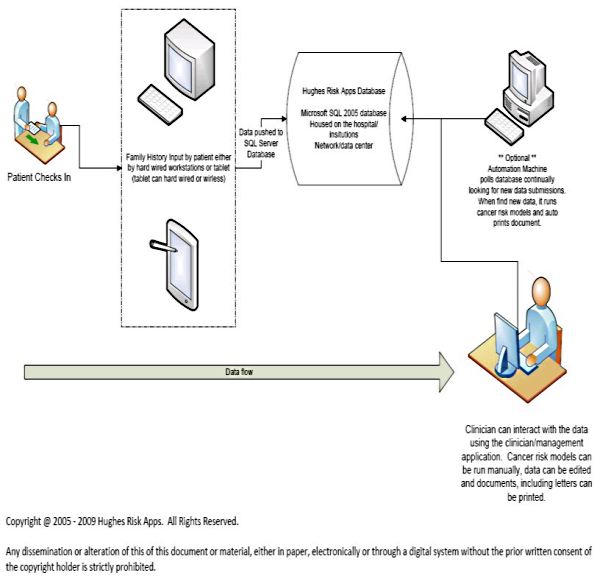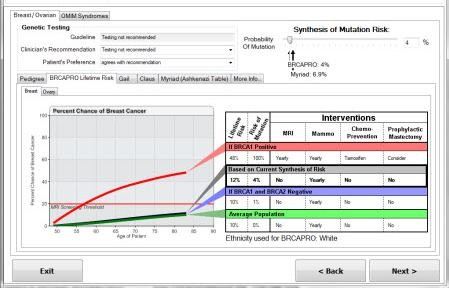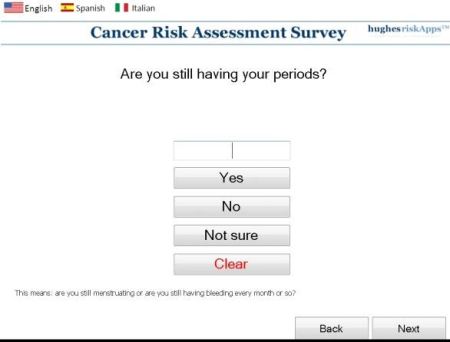![]() Risk Assessment
Risk Assessment
Overview
|
Appointment Package
|
Bone Density
|
Breast Density
|
CAD Connectivity
|
Data Migration
|
DICOM
|
Navigator
PenConnect
|
PenFetch/Plus
|
PenHL7
|
PenProfiler
|
PenWHF
|
Risk Assessment
|
Softcopy Integration
|
Voice Integration
Hughes riskApps™ Integration
PenRad now offers an interface to the Hughes riskApps™ cancer risk model and patient survey. This integration expands the access PenRad customers have to various risk models helping to identify and manage women at high risk for hereditary cancer.
Hughes riskApps™ calculates additional risk factors beyond the risk models available in most mammography information systems. The Hughes riskApps™ and patient kiosk/tablet survey software connects to PenRad’s database, eliminating the need for duplicated data entry. The patient survey application can be used as a paperless survey for breast centers instead of an interactive interview with the patient. Extended risk assessment models can provide facilities additional data to qualify recommendations for BRCA testing, MRI, BSGI, MBI and full breast ultrasound exams.
Hughes riskApps™ was originally conceived and developed by Kevin S. Hughes, MD and Sherwood S. Hughes of the Massachusetts General Hospital to identify and manage women at high risk for hereditary cancer. The application is the work of a consortium of the Massachusetts General Hospital, the University of Massachusetts at Lowell, and the Newton-Wellesley Hospital.
The system offers a patient populated survey of his or her own family history and risk data using a wireless touch tablet or kiosk PC (in various languages) or input and review by a clinical staff member. When using is wireless tablet, no patient data resides on the tablet eliminating concern of data loss or an inadvertent HIPAA violation.

Once the survey data is received it is analyzed for BRCA1 & 2, MLH1, 2, 6 mutations as well as for breast, colorectal, endometrial, ovarian cancer risk, for five year and life time percentages
In addition, the Hughes riskApps™ application generates a graphical pedigree of family history, recap family history, and risk calculation results in numerical and graphical formats available on screen or as a report printout. Results include output from the BayesMendel models, BRCAPRO, CLAUS, GAIL and MYRIAD models.
The BayesMendel model calculates risk for several cancer risk models, including breast, ovarian, colorectal, endometrial, and pancreatic cancers, as well as melanoma. It does this by invoking the BRCAPro, MMRPro, PancPro, and MelaPro BayesMendel risk calculation models. These risk models are jointly included in a set of software algorithms known as the BayesMendel R package, that is maintained by Dr. Parmigiani and colleagues of the Dana-Farber Cancer Institute. These algorithms take family history data such as disease occurrences in family members, genetic test result data, and tumor marker data, and calculate probabilities for genetic mutation as well as probabilities for cancer in various time periods.
Clinician Application
The Hughes riskApps™ Clinician Application provides physicians and clinic staff the ability to interact with patient data, run breast, ovarian and colorectal cancer risk calculations, print surveys with graphical pedigrees and letters for patients and referring physicians. Extended risk functionality allows for entering additional information related to genetic testing of patients and family members as well as decision support for future treatment plans of high risk patients.
Tablet Application
The Hughes riskApps™ tablet application allows patients to navigate a questionnaire and provide answers to both family history and life style questions.
The Standard questionnaire, which takes 2 to 4 minutes to complete is a basic set of questions aimed at identifying patients who are at potentially high risk. High risk patients may then be referred to a high risk clinic program where they can answer the Risk Clinic questionnaire which takes 10 to 20 minutes to complete varying on the complexity of a patient's family history.

